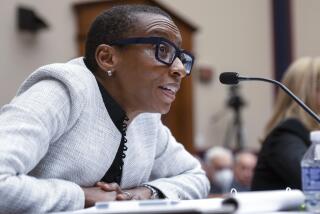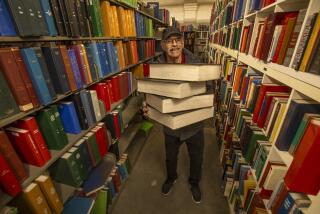Bogus Rare Editions Involved : Sleuthing Librarian Stalks Forger
- Share via
Sherlock Holmes would have loved it. Accusations of foul deeds with fouler consequences. A labyrinth of evidence, tiny clues sprinkled in obscure places where only the erudite care to tread.
Yes, it seems that the gentlemanly and scholarly world of book collecting is about to be shaken by allegations of a forgery scandal, the likes of which has not been seen for half a century.
At the moment it’s all very hush-hush, limited to a select circle of connoisseurs and experts. But an open ear could pick up fascinating tidbits last week while the International Assn. of Bibliophiles was in town, with about 150 collectors and their families trekking between rare book libraries and Disneyland, among other places.
Target Date Next Spring
In a nutshell, a British librarian, editor and book collector promises to unmask, possibly by next spring, a forger who has created specious rare editions of the actual works of W. H. Auden, T. S. Eliot, James Joyce, Dylan Thomas, William Butler Yeats, Stephen Spender and “a number of other literary heroes of our time.” (This scandal-in-the-making involves the forgery of printed books, unlike the recent Hitler diaries brouhaha, which involved falsification of the private, unpublished papers of the Nazi dictator or last decade’s bogus biography of billionaire Howard Hughes by Clifford Irving, which never made it between covers.)
Nicolas John Barker, head of conservation for the British Library Reference Division, said that for the past 15 years or so he has been stalking the suspect, whom he refused to name. So far, he said, he has catalogued 38 items he believes to be forgeries, including an issue of Auden’s “The Sphinx,” allegedly printed in the 1930s but with a typeface that was not produced until the late 1950s.
When his book on these dastardly deeds is published in Great Britain sometime next year, Barker predicted that “a certain amount of critics in England and America are going to have egg on their face.”
His revelations would have been made much sooner, Barker said, if it were not for publishers’ worries over libel laws, adding that it has taken him years to find a publisher willing to take the risk.
Barker’s comments were made after he revealed the existence of the forger in a luncheon speech to the bibliophiles at the Music Center in which he also detailed a similar case.
Before uncapping the surprise ending to his talk, Barker described at length the shenanigans of Thomas J. Wise and H. Buxton Forman, two seemingly impeccable Englishmen who forged the minor works of many 19th-Century writers, including Elizabeth Barrett Browning, Alfred Lord Tennyson, Rudyard Kipling, Matthew Arnold, George Eliot and Robert Louis Stevenson.
Front-Page News
When their deceptions were finally revealed in a book in the 1930s after a long, laborious investigation--while Wise was still alive--it was front-page news. “Paper pulp became bloodstains . . . the long question mark (in a type specimen) was like the revolver with its unique bullet, the most obscure points of bibliography for once found themselves on the front page of the popular press,” Barker said. In fact, Barker said, the book did not name outright the forgers but pointed a finger with this sentence: “We find it difficult to believe that Mr. Wise cannot guess the identity of the forger.”
Indeed, it seems that there are many odd coincidences between the two cases, not the least being the superficial similarity in background between Barker and forger Wise. As Barker noted wryly in his speech, both received degrees from Oxford, and joined many of the same clubs and associations, including the Bibliographical Society.
Barker also noted that sleuthing out book forgers is a classic example of the art of detection, involving broad knowledge and painstaking examination of the evidence. The chemistry of paper-making and the idiosyncrasies of type design were two trails that led to the unmasking of Wise and Forman and, presumably, their latter-day disciple.
Wise and Forman deluded collectors and scholars on both sides of the Atlantic, particularly Americans, and made a pile of loot, perhaps as much as 100,000--then an extraordinary sum, in the final years of the last century.
The latest forger was not so lucky--or wealthy, according to Barker.
“He has not made a lot of money,” the sleuthing bibliophile said in an interview. “He was spotted too quickly by an astonishing piece of bad judgment and bad luck.” The forger was most active between 1967 and 1972 but has since gone out of business because “he knows that I know,” Barker said.
In recent years, Barker has also devoted himself to unearthing more forgeries by Wise and Forman, taking over from the original investigators, John Carter and Graham Pollard, who died in 1975 and 1976.
Toward the end of his speech--filled with points on the maddening near-uniformity of 19th-Century text type--Barker called for collectors and scholars alike to beware of false books.
“As a matter of record, and in case anybody thinks that this (the Wise and Forman forgeries) was the agreeable foible of two scholarly old gents, my private belief is that they cannot have made less than 40,000 gold pounds of pre-1914-1918 war money out of all this and it could easily be 100,000,” he declared. “They are a detestable couple on any account and closer acquaintance does not warm them to me.”
Then, with a dramatic flourish, he added, “Now as Grace Kelly said in ‘Rear Window,’ holding up her nightie, for a thrilling preview of a forthcoming attraction. Why, you may say, worry about the long past malpractices of two petty rogues? Well, it is possible that the increase in human knowledge may be its own reward, but I doubt if that would be reason enough now. The real reason is that it can still happen now.”
Barker then called for a slide showing the title page of Auden’s bogus “The Sphinx.”
“The author of this and other forgeries . . . is still alive and well. . . . He, they, may have other successors. Only constant vigilance can stop history repeating itself.”
Two Classes of Forgers
Barker also warned that “there are two classes of forgers, those who do it for the money and those who do it for its own sake, to delude themselves as much as others. It’s hard to say which is more dangerous, the one who cons you now or the one whose deceit may not emerge for a century or more, perhaps permanently distorting the course of scholarship.”
All of this apparently was not a surprise to some of the bibliophiles, an international group of wealthy collectors, librarians, binders and others who are passionate about books.
Fred Adams, the association’s president, said he knew the identity of the alleged forger and that, “I’ve played squash with him, but it’s been years.”
Both Adams and Herbert T. F. Cahoon of New York’s Pierpont Morgan Library agreed that the alleged forger was an author.
While no one questioned admitted to being bilked by the forger, members of the association clearly took delight in the topic of forgery. At UCLA’s William Andrews Clark Memorial Library, the group spent a morning poring over display cases containing an exhibition of forgeries by Wise and Forman. It turns out that the library’s founder was duped by Wise many times. The library’s collection includes 19 works fabricated by Wise and his accomplice. The forgeries will be on display until mid-December.
One association member, Scotland’s Earl of Perth, admitted, “I’m always intrigued by forgeries, the whole idea of forgeries.” Another member, Mihai H. Handrea of the Carl H. Pforzheimer Library in New York, said, “Sometimes it’s good to have forgeries because they form grounds for comparison.” If there is honor among thieves, he added, forgers probably have it in abundance. “Forgers believe themselves to be gentlemen and artists,” he said.
But Handrea said he has never been tempted by the deceptive art himself. “I’ve never forged anything except my parents’ signatures on school papers and that was a long time ago,” he said.
More to Read
Sign up for our Book Club newsletter
Get the latest news, events and more from the Los Angeles Times Book Club, and help us get L.A. reading and talking.
You may occasionally receive promotional content from the Los Angeles Times.









